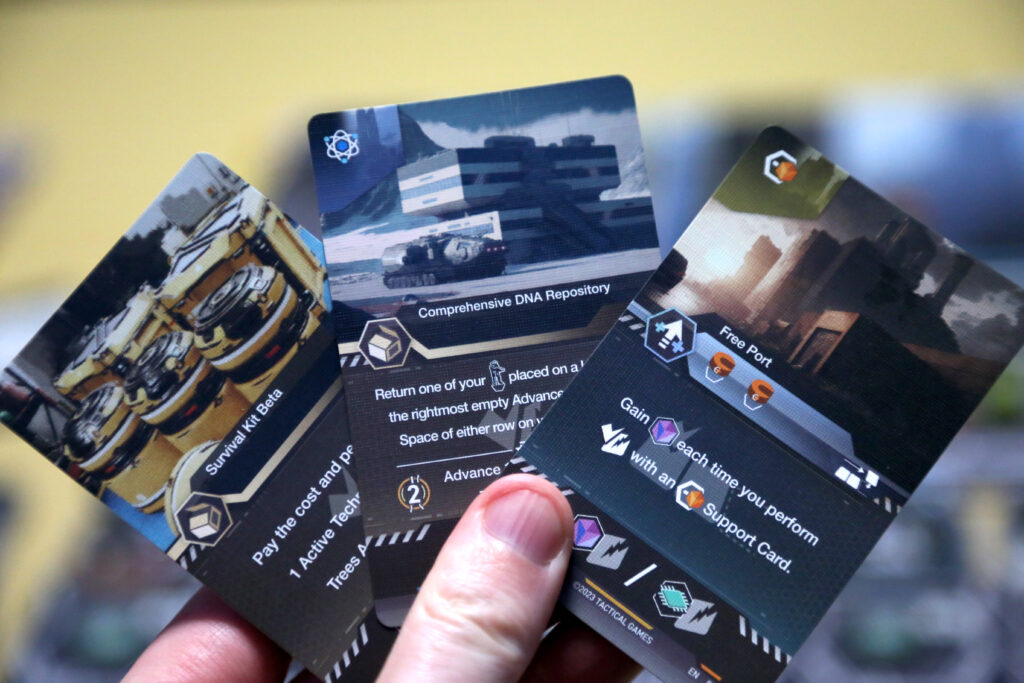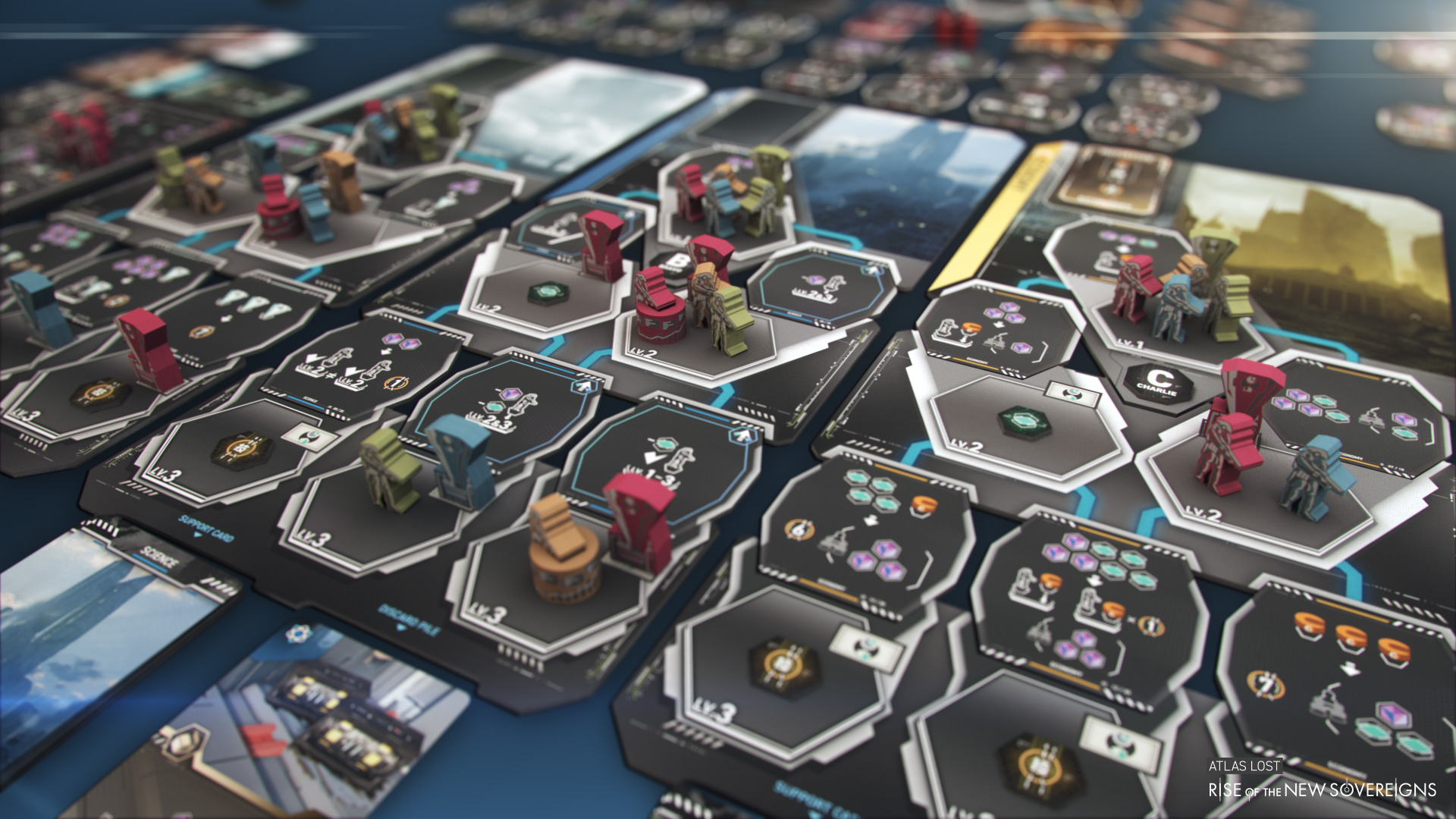This article originally appeared in the April 2024 issue of Connect.
Jon Solmundson (Hokkaido)
When talking about board games, American games are often thought of in terms of big, fantastical conflicts; while European games have a reputation for being carefully calculated, if plodding, economic puzzles. These categories are crude, often inaccurate, and become increasingly irrelevant as the internet enables a rapidly growing, global board game design culture—but of course, any creator’s culture is going to shape their work. Japanese homes generally offer less space than is available to folks abroad, and a lot of Japanese have less leisure time to burn playing games. In my experience, this means there’s often a bent towards smaller boxes with more minimalist graphic designs, and a focus on each moment of play providing a little bit of joy, rather than building up to an explosive conclusion where one player dramatically seizes the victory.
Atlas Lost: Rise of the New Sovereigns, designed by Chuo Totsuca and published by Tactical Games, struck me as an interesting blend of styles when I first saw it. It’s a big box crammed full of pieces, but you won’t even use half of them in any given game. Its rulebook and cards are overflowing with sci-fi proper nouns and the apocalyptic imagery of concept artist Kazuma Koda (renowned for his work on video games like Nier: Automata and Fire Emblem) but mechanically, it’s a fairly restrained resource trading puzzle. And, to top it all off, Chuo’s most widely praised prior game was the adorable Aqua Garden, which finds great success through the joy of playing with its many different colourful, cute, wooden fish tokens. Atlas Lost has all the same lavish production, with dozens of intricately detailed little wooden army guys to push around and slot into things. . . but, compared to the relaxing task of piecing together an aquarium, a grimdark civilization reconstruction simulator is a much stranger fit for that particular delight.
What to do after the world ends

In this post-apocalyptic wasteland, up to four players lead their own faction of survivors. You’ll be deploying “Advance Teams” into the ruins of the past society to recover useful technologies, and hopefully take control of this new world. These technologies are where the game takes its big swing: of the game’s five “Tech Trees” (Science, Economy, Culture, Religion, and War) you’ll choose only three each time you play.
The result is similar to games where you choose your own character, deck, or special powers before the action begins: it keeps things fresh from session to session, and gives you new strategies to explore. However, Atlas Lost spreads its options across an interesting and explicitly marked scale. Religion and War powers generally interfere with other players, while Science, Economy, and Culture powers have more limited reach. The game essentially asks: “Do you all want to keep to yourselves or mess with each other? And how messy do you want this to get?” with the rulebook backing this up by assigning each tree a value for conflict and resource generation.
This successfully delivers varied sessions that serve up on the promised level of player headbutting, but that doesn’t mean all the options are interesting. Most of the Science and Economy technologies are so insular that playing with both often feels like the other players might as well not be there. While this kind of personal puzzle game is something I often enjoy, all of the objectives in Atlas Lost are calibrated to make sense if people are fighting over them, causing the race to feel oddly anticlimactic when conflict is totally absent.
I Love It When a Plan Comes Together

To win, you want to be the first to score 30 points (the two alternative paths to victory: holding majority control of the board or climbing the “influence” track, rarely came up in my games). You get these points by trading in your resources via technologies you’ve researched, and with the game fitting itself into a wonderfully brisk 90 minutes once players know the rules, you’ll hit that number sooner than you might think. Atlas Lost’s greatest boon and bane is that victory mostly involves planning an efficient route towards a single technology, then liberally abusing it.
Hatching and executing your plan is a hoot. Good puzzles make brainy folks feel smart, great puzzles make everyone feel like a genius. Atlas Lost manages to repeatedly deliver the better side of this equation. The actions available to you on your turn are all relatively simple: you can take resources, spend resources to get new technology, or use a technology you got previously to give you resources or points. If you’ve played a few board games before, you’ve likely seen a similar “resource conversion” puzzle (Concordia, Century: Spice Road, and Oh, My Goods! are brought to mind). It’s well executed here, but certainly not groundbreaking.
In addition, as you do your research and grab resources, you’ll be awarded with special cards from each of the game’s tech trees. These are absolutely the game’s highlight, offering powerful, but situational special abilities, which are exclusive to the player who draws them. They make for a very rewarding “aha!” moment when you click the perfect one into place. All of a sudden, the pieces of your strategy all align and you’re spewing out points—but your opponents will never be bewildered by this; the rules and iconography are clear, the effects are easy to follow, and the graphic design is excellent at drawing attention to the important information.
However, once one player is on the victory road, the game’s core problem emerges. With that combo in place, your best option is usually just to repeat it two or three times to win, maybe taking a break to gather up resources in between. If you’ve done any preparation before firing off your points-generating engine, your opponents often can’t do anything about it, which can lead to a very stagnant, rote endgame. In your last couple turns you’re likely to be all out of interesting decisions, but as there are still numbers to crunch, you can’t just breeze through them. This left me wishing the game found a way to wrap up about ten minutes before it actually did.
All Dressed Up with Nowhere to Go

Not all my gameplays stalled right before the finish line, but enough did that I was encouraged towards riskier strategies, more to keep myself entertained than because they were genuinely advantageous. Moreover, once the end loop sets in, the game’s narrative framing falls away completely. “I trade purple coins for these things, and score six points” becomes the refrain. With many of the cards bearing evocative, thematic names, it strikes me as an odd choice that the main focus of the game’s table presence (the big central board of advanced future “technologies”) has no descriptive text on it whatsoever; just icons to represent resource transactions. Titles here would have really helped to paint a story around what players were actually doing. Without them, it risks being reduced to a joyless spreadsheet.
This creative omission is made even stranger by the fact the game otherwise comes across as overproduced. The little wooden figures each have their own slotted holding cells, all clicking neatly together in front of each player, with unique tokens for each tech tree. These are undeniably fun to tinker with, but most of the same effect could have been achieved with simple wooden cubes and disks. The Tech Trees also begin with these big cardboard mats (one for each tree, five in total) which could have easily been replaced by tiles similar to those used for all the other technologies in the game, cutting the required table space in half. I freely admit it’s an odd complaint; the game looks and feels great to play (special mention should go to the superb choice of sandy toned colours for the player pieces, which stand out from the board without clashing against the game’s dark aesthetic). But because the design is otherwise so restrained and formulaic, it’s hard not to see the occasional design excessiveness and ask “why?” when the game could have been two-thirds the size, and perhaps a couple thousand yen cheaper.
It does give more space for Koda’s art (along with the other three contributing artists: Nao Miyoshi, Yota Suzuki and Daigo Tanaka) which, as in Nier, makes striking use of man-made monoliths juxtaposed against barren landscapes to successfully evoke an oppressive, dire mood. However, the post-human societies and reclaimed-by-nature aesthetics that highlighted Nier’s best set pieces are largely absent from the abstract landscapes of Atlas Lost. What remains is a compelling collection of sci-fi locales and structures, but a notable lack of people or life to really make the world pop out from its cardboard confines.
Final Thoughts

In trying to blend all its influences together, it’s remarkable that Atlas Lost is able to deliver such a satisfying game across the board, but it ultimately feels spread a little thin. While the core idea of its modular rules initially drew my curiosity, by playing it safe within those modules, the design never quite reaches the heights of its peers, which commit harder to blazing out in one particular direction. It’s a good game, maybe even a great one if you like the vibe it has going on, and while I’ll happily play it again in the future, it feels like it’s missing a special hook to keep it top of mind when I’m wondering what to pull down from the shelf on game night.
Jon Solmundson is a Canadian-born, Australian-raised English teacher living in the snowy cabbage town of Nanporo, Hokkaido. He currently edits CONNECT’s Travel section, but when resting his exploration-weary legs, he enjoys nothing more than a spot of tea and a slow afternoon of moving wooden sheep and vegetables around a cardboard paddock.



![CONNECT ART ISSUE 2024 SUBMISSIONS [CLOSED]](https://connect.ajet.net/wp-content/uploads/2024/04/ARTISSUE-INSTA-600x500.png)





